I reached the limit of my desire to re-enact Little House On The Prairie every time our power goes out. So, we bought a generator. Today I’ll discuss why, what type of generator we got, how to assess a range of price points for the same product, and perhaps most importantly, why we waited four years to make this purchase.
The 1870’s: Not For Me
I’ve tried living a la the 1870’s and, I’ll be honest, it’s not for me. I can get behind the dresses and bonnets, not to mention the quilts, but that’s where my interest stops. Modern conveniences were invented for a reason.
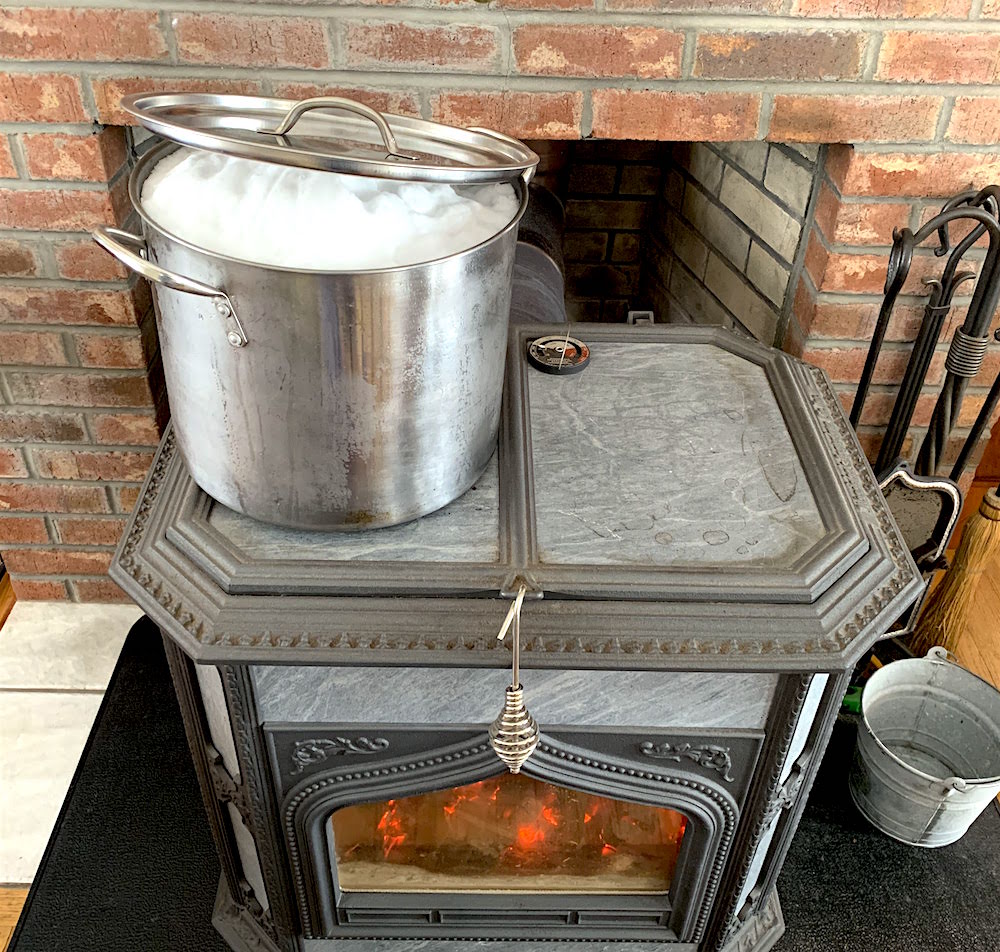
The biggest issue for us–here on our rural Vermont homestead–is that when the power goes out, we have no running water. I can live without electricity for a week. Candles and flashlights are fine, we cook with gas, we heat with a wood stove, and perishable foods can go in coolers outside in snow banks.
But folks, I draw the line at no running water. We have a well and that well is operated by a pump, which is operated by electricity. So when the power goes out, there’s no water, there’s no flushing toilet, and did I mention there’s no water?
The second biggest issue is that our phone is VOIP (voice over IP) and our internet is fiber optic cable, which runs… you guessed it… on the power lines. Most of our power outages are due to a tree falling across the lines, which means power, internet, and phone are usually all taken out in one arboreal accident.
The dream of the 1890s is alive in much of Vermont, but not so much for me. At least not while I have two toddlers in the house. If it were just me and Mr. Frugalwoods, we’d be willing to rough it (maybe… or maybe not).
The Wait and See Approach to Expensive Purchases
Mr. FW and I’ve been discussing the purchase of a generator since we bought our homestead four years ago. Coming from the city, we had no experience of rural power outages (or rural life at all, for that matter) and we weren’t sure how annoyed we’d be by losing power. So we decided to test it out, to wait and see, to experience first and buy later.

I’m a big fan of the wait and see methodology because I hate the thought of buying something expensive that I might never (or rarely) use. Since the previous owners of our property didn’t have a generator, we reasoned perhaps the power doesn’t go out all the often. So we settled in and waited and see-ed.
Here’s what we’ve learned: the majority of our power outages occur in the winter as a result of snow and ice building up either on the power lines themselves or, more often, the trees near the lines. Enough snow/ice will fell a tree onto a line. Rude. Occassionally we have wind-related outages at other times of the year (occurring when wind knocks a tree over), but winter is definitely power outage high season.
Our first two Vermont winters (2016 and 2017) delivered minor power outages that only lasted a day at most. Nothing major and not enough of a hassle to prompt a generator purchase. We decided to enter our third winter, the winter of 2018-2019, without a generator, hoping for a similarly light touch of the old frosty fingers. You know, just enough outages to make us grateful for electricity, but not enough to make life uncomfortable or anything.
The Winter of 2018 – 2019 Had Other Ideas
Last winter was bent on bending branches and icing roads and just generally being a pill about everything. At the end of last November, we were without power more days than we were with it. That life experience prompted the following, excerpted with edits, from my December 2018 On The Homestead post:
Power Outages Pre-kids
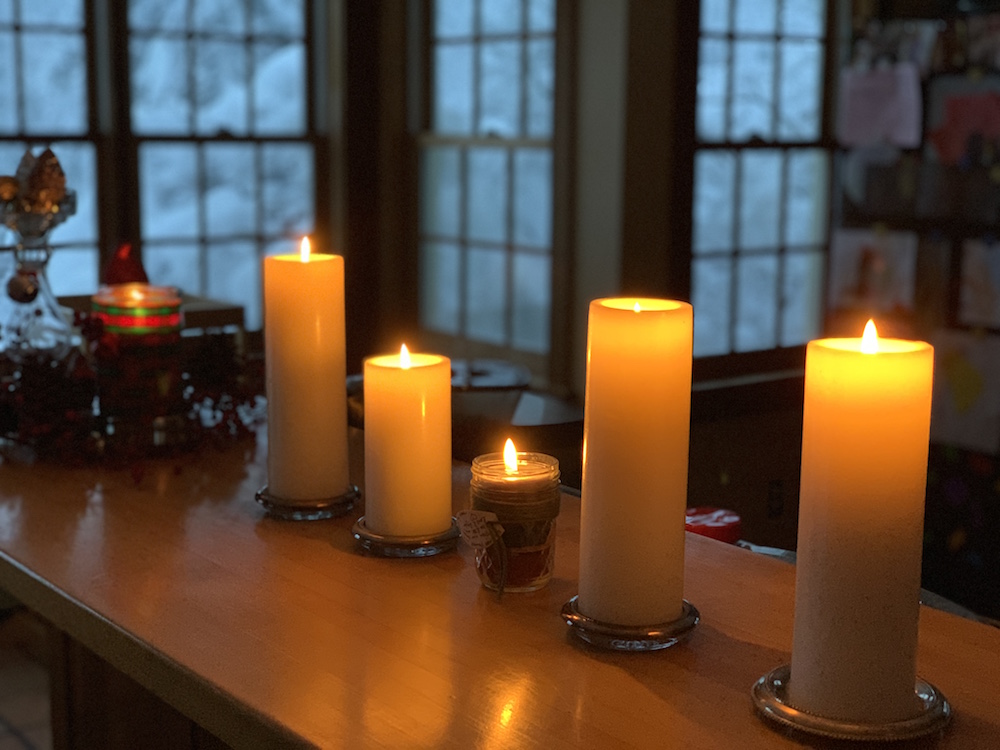
The height of romance! Light candles and place them on every surface–the floor too, why not! Create a cute meal of peanut butter sandwiches and open a bottle of wine. Lounge on the floor tickling one another’s chins, playing a decadent game of Scrabble. Discover a long-forgotten box of chocolates that was gifted for one’s work anniversary two years ago and drunkenly indulge. Also discover another bottle of wine.
Giggle at how silly humans are to think they need electricity all the time. Relish the absence of internet interruptions while reading Leaves of Grass aloud by candlelight as you stroke your beloved’s flaxen hair and smugly note how resilient you are in the face of such inconvenience.
Sleep soundly (two bottles of wine, remember), wake up the next day, shrug that there’s still no power, and repeat all of the above.
Power Outages Post-kids
1 minute in: we can do this. I am certain we have flashlights somewhere in this house. Locate flashlights, give one to toddler who proceeds to shine directly into baby’s eyes. Light a few candles. Extinguish candles as soon as the extended reach of toddler is discovered. Ear-splitting tears indicate it’s dinner time. Conduct a frantic search and realize you were planning to bake bread that day, but haven’t yet, and thus have very few non-perishables to feed to children.
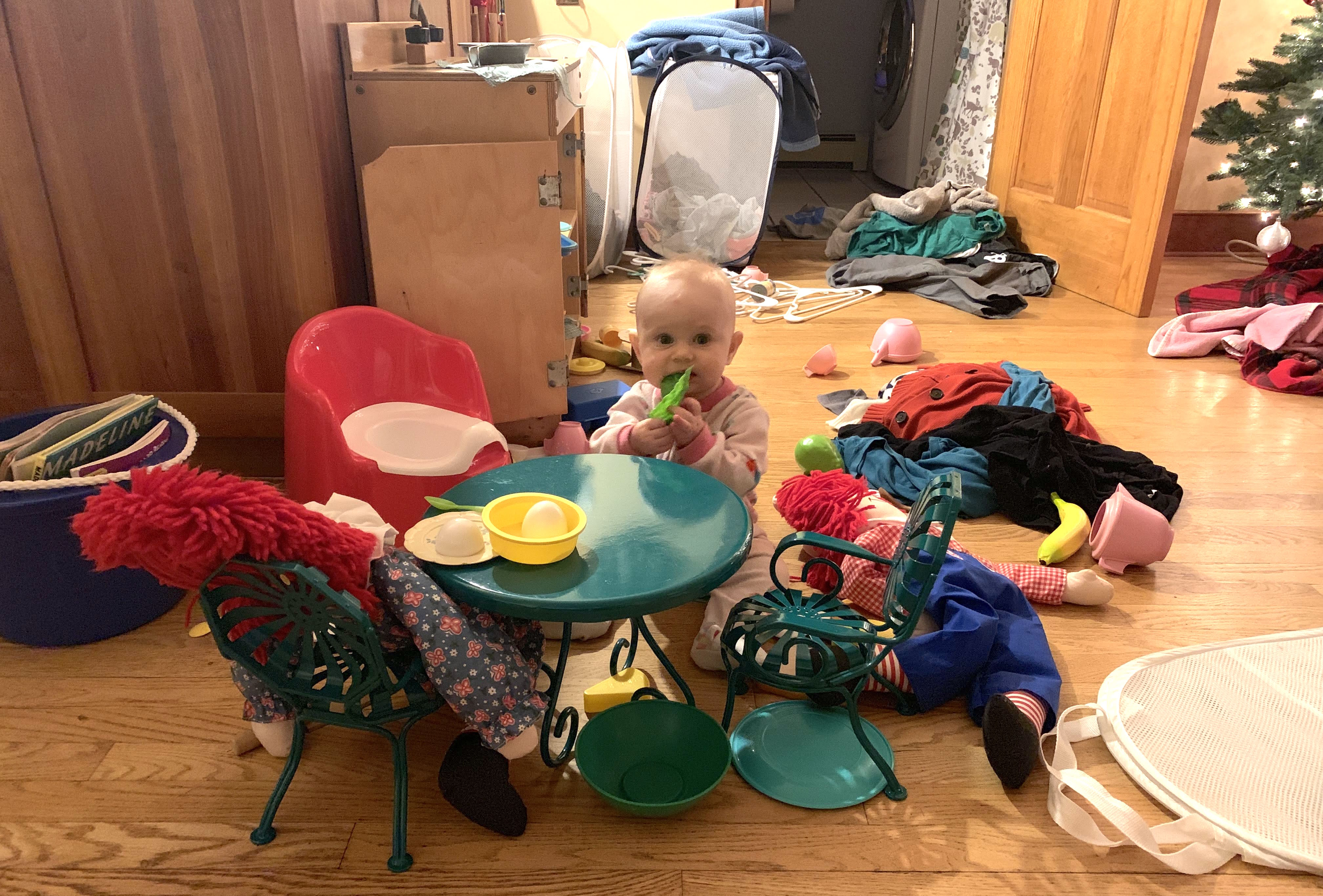
Realize you can’t open refrigerator for fear that everything inside will perish. Locate jar of peanut butter and an orange. Slather orange with peanut butter and try to convince children it’s a thing. Watch in horror as baby vomits orange/peanut butter into toddler’s hair. Realize you’ve already used 2 gallons of stored water trying to wash children’s hands prior to dinner. Use baby wipes to inexpertly clean vomit off all family members.
2 minutes in: field 9,846 questions from toddler about: which lights are out (all of them), when the ‘lectricity will return (I have no idea), how ‘lectricity works (it’s an increasing problem that you have no internet), what we will eat for breakfast (not sure we’re going to make it that long), if her noise machine and night light will work (decidedly not), and a listing of everyone she knows followed by, “is their ‘lectricity out too?” Squelch desire to scream: “I KNOW NOTHING AND AM NOT A RELIABLE ADULT CAREGIVER AT PRESENT MOMENT. ALSO WHY ARE WE OUT OF WINE? IS THERE NO JUSTICE IN THIS WORLD?!”

5 minutes in: stand holding full (super full) toddler potty and contemplate fact that, due to water not working, you can’t flush the toilet. Calculate number of toilets in home (3) versus number of toilet-using household members (3) versus frequency of eliminations. Despair. Say a prayer of thanks that you didn’t get around to doing Elimination Communication with your baby, so she is still in diapers. Be grateful that procrastination has upsides.
10 minutes in: declare an early bedtime. Curse self that nearly all bedtime rituals require electricity: baths, teeth brushing, using the freaking potty (seriously kid, again?!), turning on the nightlight and noise machine. Forgo all. Settle for reading books by candlelight–kidding!–flashlight. Attempt to wipe layers of grime off children via baby wipes. Begin to detest scent of baby wipes. Put dirty children in jammies and futilely hope for best.
15 minutes in: wonder what the parents will eat for dinner since appetite for peanut butter and orange was obliterated.
Other than that, we had a magical time.
How Expensive Of An Inconvenience Is It?
Following last winter’s extended historical re-enactment and several early fall outages this year, we decided Generator Time was upon us. But what type of generator to buy? How much to spend? Generators range wildly in price from a couple hundred bucks to over $10,000(!!!). We had to decide how much we were willing to spend in order to prevent a power outage. The way I consider a purchase like this is: how expensive of an inconvenience is it?
I use the metric of inconvenience for a lot of stuff because it helps me identify how much money I’m willing to shell out for any given “convenience” item. And let’s be honest, just about everything we buy is a convenience item. Once you’ve got your food and shelter needs covered, just about everything else is a convenience purchase.
Here are a few non-generator examples from my life:
1) A Carseat For Every Car

We have two kids and two cars. With our first daughter, we bought only one carseat base, which meant we had to lug the seat from car to car anytime we changed cars. This didn’t sound like a major issue to us before she was born and so, we dutifully latched, carted, and re-latched between our two cars. With a screaming baby. In the freezing cold (she was born in November after all). On a city street since we had no driveway and no garage and no assigned parking spot. That got old fast.
With our second baby, we were firmly on team A Carseat For Every Car.
Yes, it’s a luxury, but it’s worth it to us to spend the money on four carseats to avoid transferring seats every time we switch cars. Especially since we both drive both cars equally and we still have no garage and it’s still freezing cold most of the year. As a matter of fact, we hate transferring carseats SO MUCH that I bought a carseat for our adopted grandma to use in her car and I just bought this carseat and had it shipped to my in-laws for use during our next visit (affiliate link).
2) Bedroom Slippers That Fit
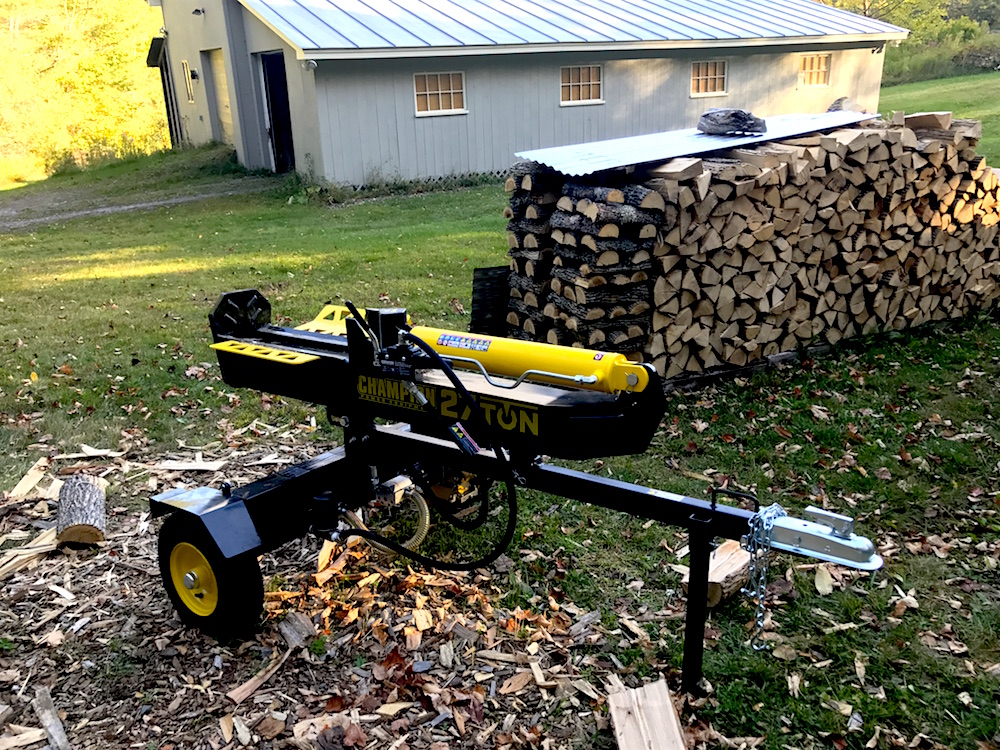
Laugh all you want, but I minced around in bedroom slippers that were too tight for six months before I finally bought a new pair. I realized it was dumb and inconvenient to have aching toes. Since I work from home, I wear slippers all day every day (now you know how glamorous I am… ). I bought this pair of moccasins and never looked back (affiliate link). I have super long, super narrow feet (9.5, double A) and these are the first slippers I’ve found that come close to fitting (they’re still too wide, but less wide than everything else I’ve tried).
3) A Woodsplitter
We heat our home with wood and Mr. FW harvests, splits, and stacks this wood himself from our forest. For the first two years of our homestead life, he split wood by hand with an axe and maul. It’s totally possible to do this, but it takes forever and it limited the type of wood we burned since some woods (usually those that burn most efficiently) are too hard to split by hand.
After two years of hand splitting, he decided to invest in a wood splitter and is thrilled at the increased efficiency and speed. He was able to get us to our goal of filling up our entire woodshed (which he built himself) with nine cords of wood, which will last us three winters. This wouldn’t have been possible if he were still splitting by hand.
The Two Year Rule: Taking The 72-Hour Rule Up A Notch
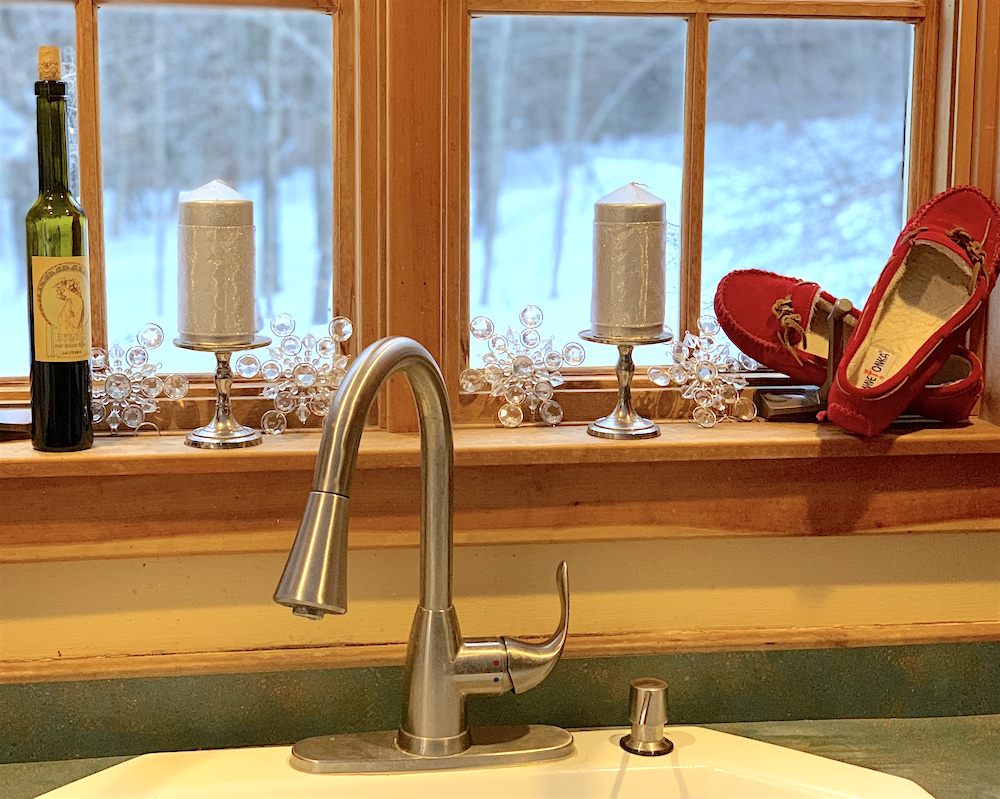
The thread that weaves all of the above purchases together is the idea of testing out the cheap alternative BEFORE diving into the more expensive solution. In this age of endlessly available products that promise to solve every conceivable inconvenience, it’s possible to enter into a state of constant consumption. I could buy stuff for literally every single moment and experience of my life. So how do I push through the advertisements and prompts? I wait.
This form of waiting is an advanced technique to layer on top of my now-infamous 72-hour-rule. My full post explaining this approach is here and I’ve excerpted the relevant bits below:
The 72 hour rule: do not buy anything (except for out-and-out necessities like prescription medication) for at least 72 hours after you initially consider buying it.
- Next time you want to buy something, write it down instead
- Allow 72 hours to pass
- During this time:
- Consider whether or not you actually need the item
- Calculate what else you could do with that money
- Explore if you already own something that could suffice
- Ask yourself if it’s something you could find used for a much cheaper price
- After 72 hours, reevaluate how you feel about the item. Do you still want it? Do you need it? Or has the desire faded?
I apply the 72-hour rule to smaller purchases, such as spatulas. For things like the generator, the wood splitter, and the carseats, I wait a lot longer because they’re a lot more expensive. This waiting time isn’t meant to be miserable or to induce a state of deprivation. Rather, it allows me to think through a purchase carefully and consider all of my alternatives. In some cases, the wait time is years long; in other cases, it’s a few weeks or months. Thinking of a sliding scale is helpful: the more expensive the item, the longer I wait before buying it. This isn’t always possible or even reasonable, but for stuff that’s not an immediate necessity, I think it prevents a lot of unnecessary spending. Ok, let’s get back to the generator.
Generators: Evaluating Price Points from $500 to $10,000
The Ritzy Option

At the top end, there are automatic standby generators, which automatically switch on when the power goes out. These things require nothing from you and they immediately power your whole house. Nice, right?
The only problem is that they cost around $10,000 if you have them installed by a professional; slightly cheaper if you install yourself. But the costs don’t stop there. In addition to the generator, you have to pour a concrete pad to set it on, run the electrical wiring (you’d likely need to hire an electrician), and hire a plumber or the gas company to connect the gas, a technician to set up the generator itself, plus pay for an annual maintenance regime.
Adding even more to the cost is the fact that these generators run on propane. They typically burn several gallons of propane per hour, so you have to buy–and store–a ton of propane. I recently bought propane (which we use for cooking) for $1.95 per gallon, so you can see how this cost could spiral during a several days-long power outage. Assuming the generator burns three gallons an hour, and your power is out for 48 hours, you’d spend $280.80 on propane alone–just for that one outage. Mr. FW and I decided that being without power for a few days is not a $10,000 problem for us.
The Rather Expensive Option
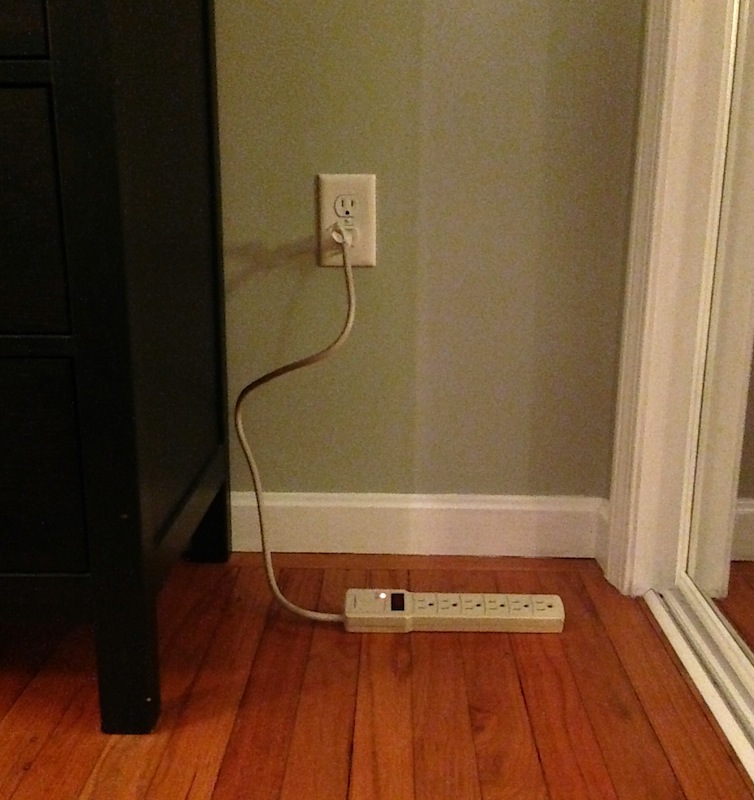
Next up on the price spectrum is the Tesla Powerwall. These work similarly to an automatic standby generator in that they automatically click on when the power goes out and you run your house on battery. The issue here is that the batteries–as all batteries do–run down and likely wouldn’t last more than a day or two. I think a powerwall could be a great option for folks who live in the city and need–perhaps for medical reasons–to always have power.
Since you rarely loose power for longer than a day or so in the city, a powerwall could make a lot of sense in that use case. But for us out here on the homestead, our worst case power outage could easily be 7-10 days and a powerwall would simply run out of battery. Plus, powerwalls are expensive (circa $8,500 to $16,000 with installation).
The Dirt Cheapest Option
On the cheap end are 1,000 – 1,500 watt inverter generators, which run super efficiently, doesn’t use much gas, and are enough to power your refrigerator and freezer (you just run an extension cord from the generator to the fridge). These generators cost between $500-$800. They aren’t powerful enough to run a whole house, but they can do a fridge/freezer and charge your laptop. If the device in question plugs into a normal outlet (such as a freezer), you can run it on one of these inverter generators. You might only be able to run one appliance at a time, but this would totally work if your power outage needs aren’t complex. Unfortunately, this cheap option wouldn’t work for us since they only output 120 volts and our well pump alone is 240 volts. Thus, these are a literal non-starter for us.
The Middle Ground
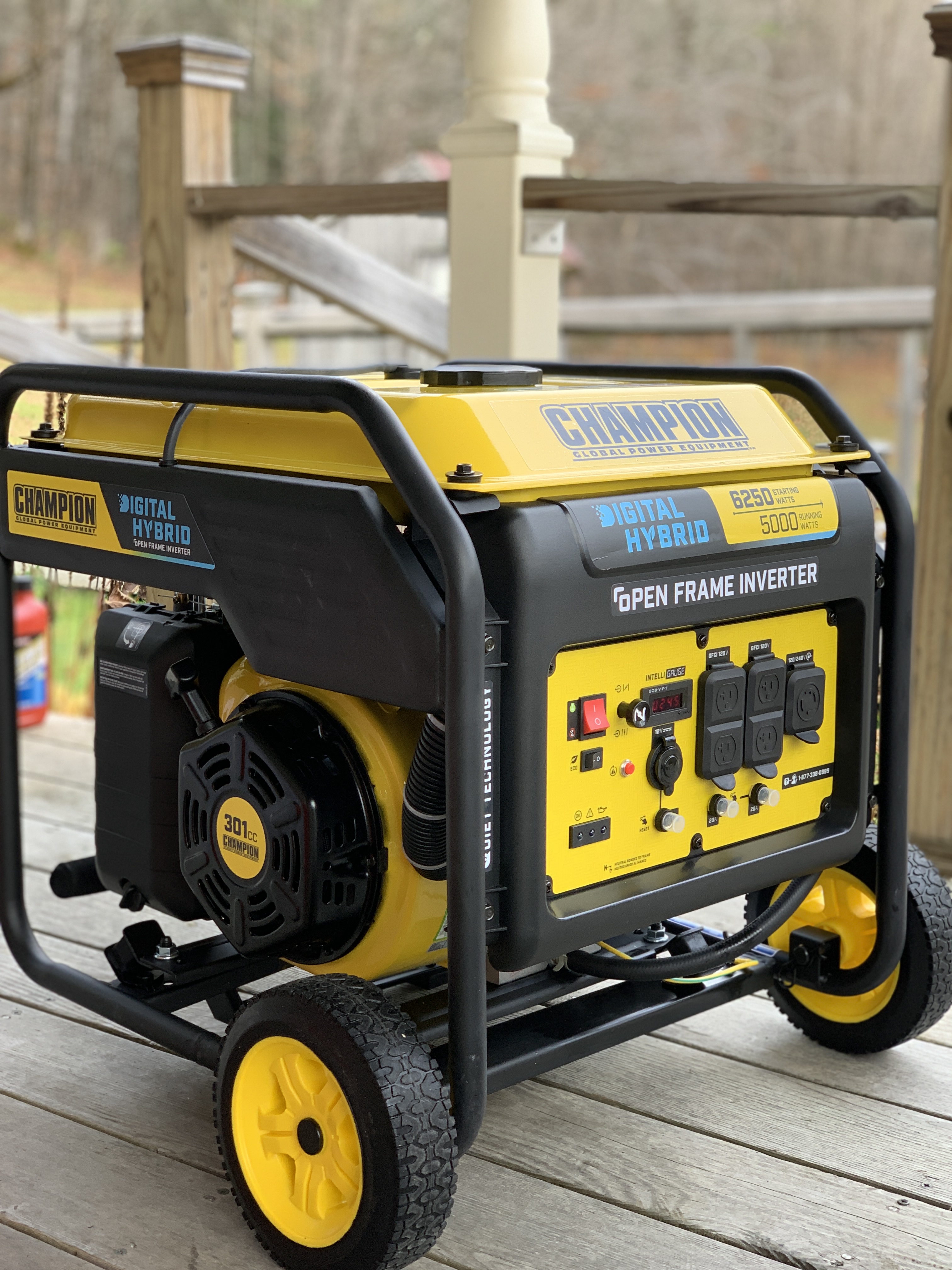
We landed in the middle and got this Champion 100519 6250-Watt DH Series Open Frame Inverter generator (affiliate link). The downsides are that it’s loud and not automatic (you have to go outside and turn it on).
The upside is that it has enough wattage to run several things at once, including our power-hungry well pump. Furthermore, at $859, it fell firmly within the price range we were willing to spend. While it is pretty noisy, it’s located outside and I find it just sounds like a low thrum from indoors. Plus, we won’t run it at night, so there are no worries about sleep interruption.
This generator is a hybrid inverter, which is a relatively new type of generator. It was slightly more expensive, but it offers better fuel economy than a regular open frame generator. We were attracted to this generator in particular because our wood splitter is also Champion brand and we’ve been very happy with it and it uses the same type of small engine. This is one of the smaller generators that will provide 240 volts, which is awesome because it uses less gas, but is enough to power our well pump.
There are several options for hooking up an open frame generator:
- Cheapest: run extension cords. This wouldn’t work for us because our well pump (and most well pumps) don’t have a plug (they’re hard-wired). Additionally, this approach means you have extension cords running all around your house, which is not ideal for our current family composition of two toddlers.
- Most expensive: install a transfer switch. This involves rewiring your electric panel and selecting a certain number of circuits to be powered by the generator. In theory, this is the most convenient approach because it’s a separate circuit, which makes it harder to overload the generator. However, we didn’t feel it offered enough marginal benefit to justify the price.
- Middle ground: install an interlock kit. This is what we did. An interlock kit is specific to your breaker box and it makes it such that the generator and the mains breaker can’t be on at the same time. This makes it safe to backfeed from the generator into the breaker panel because the interlock makes it impossible to backfeed into the utility. This is imperative from a safety perspective because without the interlock in place, the generator’s backfeed could electrocute a line worker. Thanks to the interlock, you physically cannot turn the generator on until after the main breaker is off.
Generator Installation: A DIY Project
As with just about everything related to mechanics or construction, the labor is often as expensive as the part itself. Given that, Mr. Frugalwoods decided to stretch his DIY capabilities and install the generator himself.
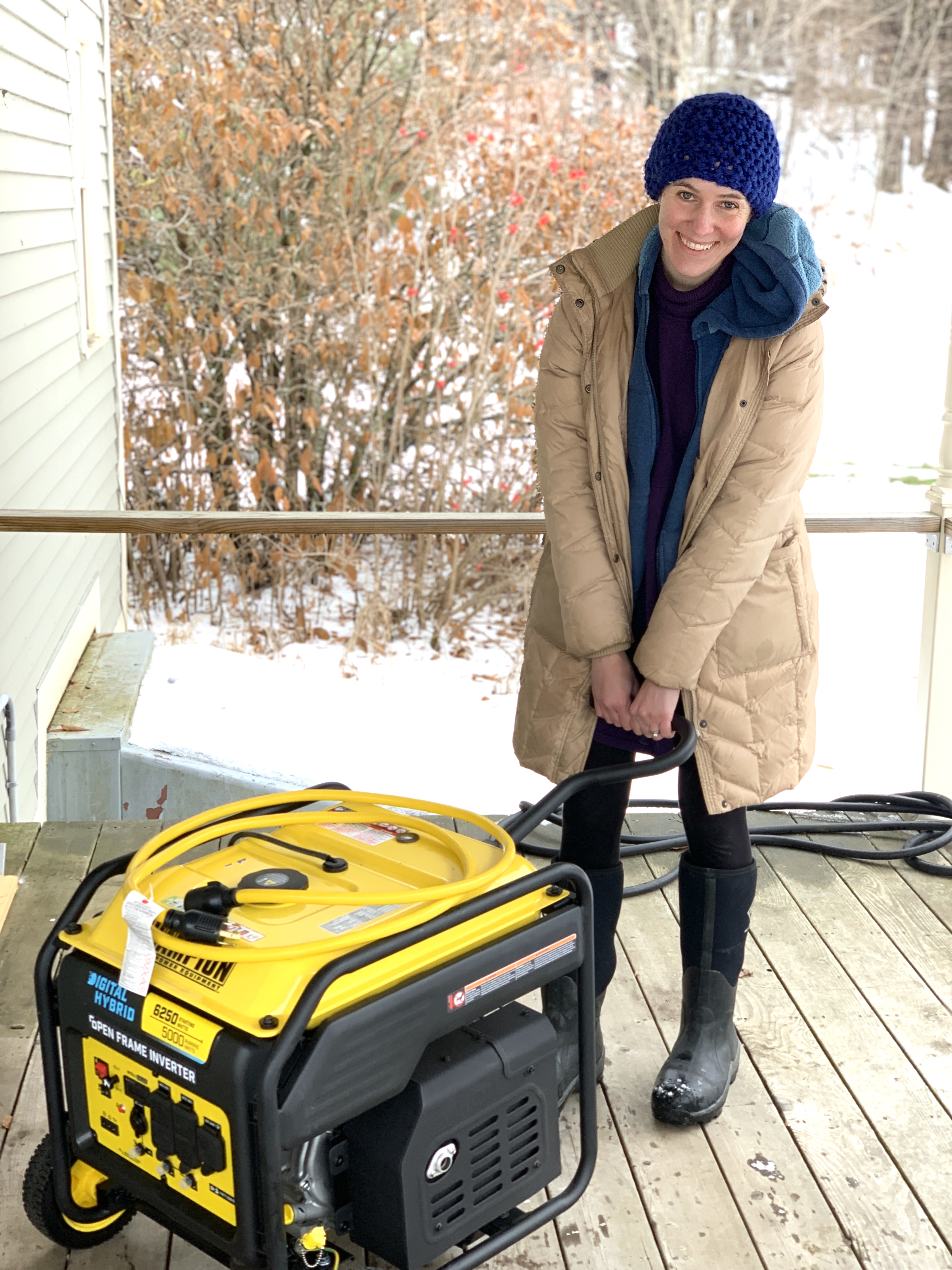
I’m continually amazed at what this man teaches himself to do through YouTube videos and online tutorials. I also appreciate that rather than see this as a chore, he viewed it as an interesting challenge and an opportunity to expand his skill set.
Here are the steps he took to install our generator:
- Installed the interlock kit, per its directions, on the breaker box panel.
- Moved the breaker located in the interlock position and installed a new breaker for the generator.
- Ran 10/3 Romex from the breaker panel. Drilled holes in all the beams of the basement in order to run the Romex all the way over to the generator’s location.
- Drilled a hole in the side of the house to run the Romex from the basement outside to the generator.
- Ran conduit from the exit point in the side of the house to the porch where he installed a generator outlet, which carries 220 volts.
- Installed a power back detector, which does just what it sounds like: it sets off an alarm when the power comes back on. Without this little device, we’d have no way of knowing when the power came back on.
- Unpacked the generator and hooked it up.
That really makes it sound easy, but it wasn’t. We decided to set the generator up on our back porch because it’s a covered spot attached to the house that’ll make it easy to turn the generator on and off and also allows the generator to stay dry. Mr. FW plans to build a wooden cover for the generator; for now, it’s living under a cardboard box.
Operating the Generator
We’ve had the opportunity to use our generator twice since Mr. FW installed it last month, so we’re feeling pretty good about this purchase. When we need to run it, we do have to follow the below procedures, because it’s not a $10,000+ automatic standby model, but it’s honestly not all that complicated to execute:
- We select which breakers we want turned on and which turned off. We turn off the electric dryer and the water heater because those two, along with the well pump, would probably overload the generator.
-
This heavy, wet snow is often a harbinger of a power outage We turn off the electricity to our solar system because we don’t want the generator to negatively interact with the solar inverter.
- The generator runs on ethanol-free gasoline with Marine Stabil added, which helps it stay fresh for up to six month. We don’t keep the generator tank full of gas because we don’t want it to go bad. Since we also use ethanol-free gasoline for our wood splitter, chainsaw, and lawnmower, we cycle through enough of it that the gas is almost always fresh.
- It then powers the whole house (all outlets and all lights and all sinks and all toilets work). We do have to be mindful of how much electricity we’re using on it. But within reason, and with LED lights and a propane stove (both of which we have), we can continue on with life as normal. Sidenote: we think we can run our water heater on the generator, but haven’t tried yet. I myself have taken many a cold shower in my day and don’t mind all that much. What I do mind is no shower at all.
- Our maintenance plan is to start up the generator at least once a month to ensure everything is running smoothly.
- The generator is on wheels and has a handle, which makes it super easy to maneuver into position.
Make Sure To Account For Total Costs
With purchases like a generator, it’s important to factor in all the ancillary costs. We didn’t just incur the cost of the generator itself, we also incurred expenses of related parts. If Mr. FW hadn’t done the installation and electrical wiring himself, we likely would’ve doubled our overall costs and spent roughly $2,000 just on the installation.
Here’s a spreadsheet detailing our total outlay on Project Generator:
| Item | Amount | Notes |
| Generator | $859.00 | We bought this Champion 100519 6250-Watt DH Series Open Frame Inverter (affiliate link). |
| Breaker, wire, conduit, and fittings | $277.74 | 10/3 Romex wire, 30 amp breaker, conduit and fittings |
| Interlock Kit | $69.00 | Interlock Kit |
| Cord | $44.21 | Generator Cord (affiliate link) |
| Power back detector | $37.65 | Power back detector (affiliate link) |
| Total: | $1,287.60 |
I will note that since we bought all of this using our cash back credit card, we got 2% back on these expenses, which is $25.75. Hey, hey, hey! This is why I love credit card rewards: they’re literally something for nothing. I also wrote this guide on how to find the best credit card for you.
Building a Gratitude Mindset
I’m glad we waited three years to buy a generator because I am able to appreciate it in the fullest sense. Since we’ve been through several lengthy power outages without a generator, I understand the luxury of having one. Had we bought a generator when we first moved here, we wouldn’t have the frame of reference for how fortunate we are. Sure, we could imagine it theoretically, but unless I experience something, it’s harder for me to access deeper gratitude.
It’s easy for me to express flippant thanks for electricity, but it’s a different thing entirely for me to understand the full ramifications of being without electricity. While the wait-and-see method saves money, it also allows me to develop a gratitude mindset. And you know I love a two-for-one.



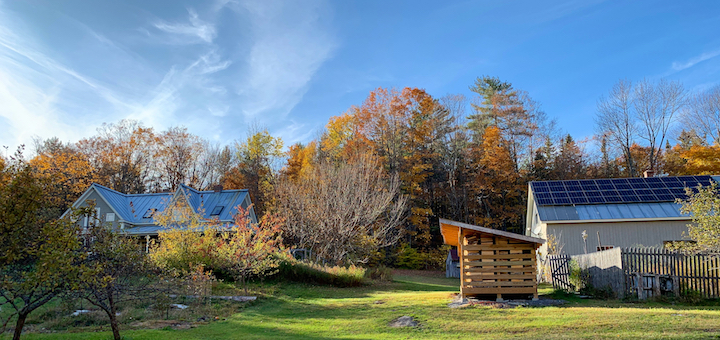



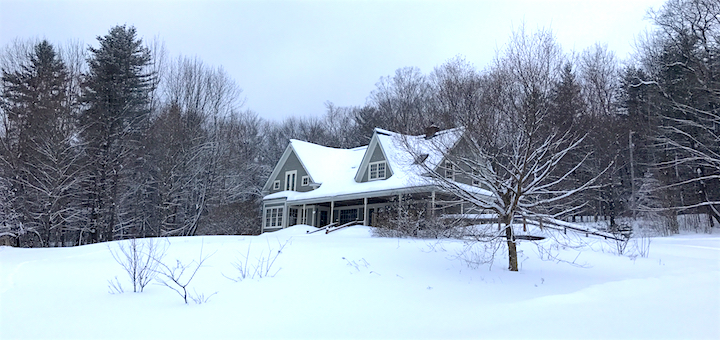

We don’t really live out in the hinterlands as you do, but because of the way the area developed, we’re on a rural power branch that is one of the later ones to be tended to because there just aren’t that many customers on it. We’re also on a well. After a more than week-long outage one year at Christmas due to an ice storm, and another because of trees down everywhere, along with multiple shorter outages, we bought an automatic switch-over natural gas generator.
We hosted multiple friends with wells for showers during a week-long outage at 4th of July caused by a storm that took down a lot of trees and power lines when the weather was approaching 100 degrees, offered them sleeping space but they didn’t take us up on it.
When we replaced our well pump prior to getting the generator, we had up-sized the pump, so when we bought the generator, it only needed a small capacity bump to also be able to run air conditioning, which gave us both more generator capacity and proved marvelous at the 4th of July outage. The only things that it won’t run (we didn’t connect them because of capacity) are the electric wall oven and the electric dryer. Some other circuits for lighting are also not connected, but everything important for habitation is covered. During the week-long outage at 4th of July, we had internet and (at the time) cable. We’re now non-cable, so the internet is supporting all of that.
Another option would be to have a battery bank hooked up to your solar panels that can run a few crucial circuits like well pump, refrigerator and some lights. I wonder how the cost would compare to a generator and gas.
Thank you for all your writing.
Thanks for the Portlandia reference.
THANK YOU for getting it. My work here is done ;).
I live in rural Western Mass, and I think it is a necessity. One of my wacky neighbor’s old maple tree branches have fallen on the wires more than once, and I’ve been without electricity for at least a week due to this during various blizzards/ice storms. Mine is wired to the house, runs the furnace, fridge, some outlets. I have a wood stove that I can cook on (I do this a lot in the winter – it’s great!), run the generator to bring the fridge up to temp, get the hot water going, flush toilets, take a quick shower. I hate being without electricity, and this makes the situation tolerable.
I love our generator. We went with the high price spread because we are retired, had downsized and hence could afford it. Before we moved to NH fulltime, we had already experienced a few multiday outages, and lived thru them. I hated being cold and having to figure out how to get a hot coffee. Now that we are older, some sacrifices just don’t seem worth it.
I will admit, in my research, I didn’t see the generator you chose. It seems great for your needs.
I’m surprised by your comments on the Tesla Powerwall, which I think lack your usual big picture vision — we live in the same neck of the woods as you do, and our powerwall was about $2000 with free installation about 2 years ago (I’d have to go look up all the specifics; I know the rebates and special deals change, but that still seems significantly different in price.) We’ve been very happy with our Powerwall, which has lasted 3 days (our longest power outage since it was installed). No, it probably wouldn’t last for 5 or 7, but we’ve never been out that longer than 4 in our 20 years here, and if we were, we figure we could rough it for that rare occurrence — gives us a story to tell! The other HUGE advantage to the Powerwall is that the power company uses it to balance power usage when the power is on — which means the utility does not have to buy power from coal-fired plants to fill in heavy usage times, but rather draws on the power it has stored in the Powerwalls spread around Vermont. I love that it’s an easy way for us to contribute to cleaner energy use while also not losing power during outages! I think it’s a fabulous solution in a rural area, and I would urge you to take a second look at it. I know that once invested in a generator, you’re unlikely to change, but I would hate for others to not consider the Powerwall because of your description.
Definitely a worth purchase! I give you mad props for not jumping in the car at the 7 minute in mark and heading to town in that very moment to buy the $10,000 option including the $2500 set up fee to have it ready to go when you arrived home that same evening….with a bottle….nay, box…of wine of course!
We love our generator but we live in a small city and don’t use it often (knock on wood!)
On another topic, we are moving from a new home to a 20 year old home as we wanted the land and the pool. It is somewhat updated but 2 of the bathrooms and the basement wet bar/carpet are not. How do you guys decide how much and when to spend on renovation projects and what matters?
Thank you!
I can only advise to live there for 6 months and then decide what is the most important or the most irritating item to you. Bathrooms can be easily redone, one item at a time. We did toilets, then shower in master because it was 20 yrs old and needing it. We waited about 15 years, then ordered cabinets for bathrooms from cliq studios, had a friend install them. Had granite cut and installed, then plumbing changed out and redone. Our guest shower was just redone 2 years ago. The tub is in perfect condition, just tore out the tile and had it redone along with fixtures. We always paid cash. Easier to piecemeal it that way. Our bathrooms cost us approximately 3000 each, except for master shower glass was additional. Bathrooms do not have to be expensive. I wish the beautiful laminates that are around now, had been around 20 years ago, I would have had that instead of tile floors. As far as the basement, these laminates would be perfect or inexpensive carpet. The wet bar can be left until last or repainted. Bathrooms done smart will always recoup the value. Good luck
Thank you so much! I appreciate it! We never had a brand new house until our last one but they were always more updated so it’s a change going from brand new everything to some updates and well built but older. However we are super excited about the acreage and swimming and also taking about $70K LESS of a mortgage which is our only debt:)
We are currently using the wait-and-see method for a second car. December will mark our second year with one car, and so far we haven’t seen the need for a second one. Sometimes by waiting you learn to live without it if it isn’t too inconvenient.
YES! That is such a perfect example. That’s awesome you’ve made it so long on one car.
I lost the ability to drive for a month (fractured right foot in a boot)… and we have been really surprised how we have been able to adjust schedules to get by with one driver in one car (we still have our second car). I’m now confident then when we hit retirement, we will just keep one car and not two from this experiment in clumsiness.
I will note that it’s been more difficult at work because I can’t pick up any supplies for programs and I work at an offsite location that doesn’t get interoffice mail pick-up… its funny how they just assume you will have an auto mobile, but my job description doesn’t require me to have an automobile, just a licence…. so I wonder how that would go if long-term, I just didn’t have a car at my disposal.
Do you both have jobs outside of the home? Or are you at a location that doesn’t require you to leave?
We suffered through the same late-November outage — all 84 hours, 13 minutes of it. No power, no heat, no water (also no kids, thank goodness). Now we have solar and a wood stove (having benefited from your excellent research, thank you very much). And a whole-house battery, paid for by our progressive utility, GMP. Oh, and a baby on the way. Looking forward to spending this Vermont winter firmly in the 21st century!
I have debated on a generator for my electric water heater only. Unlike you, I don’t especially like cold baths in the winter, however I consider this a want versus a need and haven’t purchased one yet. I use mostly canned or dried goods, have a solar cooker, only keep enough perishables for a couple of days, and live in the deep South, so a generator is not as critical for me. I am also on city water. My house is completely shaded so I am not worried about air conditioning in the summer either, even when it is 110 heat index. It would be uncomfortable, but I could take a cold bath and I am actually fairly well acclimated to my climate. I have also debated on whether to purchase and have installed a small marine wood heater. I have a small house and I only would want to heat one room, so I think a marine heater would be sufficient if I could also heat a pot of soup on top of it. I haven’t purchased either because I am still not convinced I am going to stay in my house past another five years, and a different house may have different needs.
Thanks so much for this article. We’ve considered a generator for exactly the same reason that pushed you over the edge – the well pump! We also feel vulnerable during heavy spring rains and summer thunderstorms, when most of our outages come in NW Pa, because we often have lots of baby chicks or turkeys who are dependent on heat lamps and hundreds of pounds of meat in our freezers. So far in six seasons the outages have not exceeded 8 hours but it’s definitely a risk to our farm business that worries us.
I am so very fortunate that when I bought my home, my boyfriend (who owns his own home – we do not live together) bought me a generator and had it installed as a housewarming gift. I live in the mountains and we often get power outages – that baby has been soooooo amazing – it’s a whole house generator and kicks on as soon as the power goes out. I often feel a little guilty that mine is the only house on the road with power….but I’m sure grateful to my love for that most generous gift. No doubt you have found great peace in knowing you will have water when the power goes out….I agree, that’s the worst part of being on well and septic! When I was renting….also on well and septic….we had a power outage for about a week! I brought over huge containers of water from my sweetie’s house, and was able to shower at his house, but what a pain!!!
Have a wonderful Thanksgiving!
Sadly, I anticipate that every house in a rural area will have a generator in the near future. Living in the country is not cheap in terms of utilities. When I moved to the woods in 1989, my electricity was very reliable. In recent years, my neighbors and I have had outages every few weeks. Sometimes, there is no explanation offered by my service provider. Visually, I see many dead large trees next to power lines. Two years in a row of gypsy moth infestations killed many tall oaks in my region. Eventually, many of these dead trees will crash down on power lines. Like you, I value the importance of owning a generator, log splitter, chainsaw, and wood stove.
Growing up in W.Mass we had power outages frequently, but they usually only lasted a few hours to a couple days, so we just dealt with it.
We kept cleaned/reused gallon milk jugs filled with water in the basement to force flush the toilets as needed, that being the biggest concern.
I’ve been trying to decide whether to invest in an online organizing/decluttering/goal-setting class. I’m sure it works, if you work it, but it’s not cheap. Almost pushed the “buy now” button, but paused, thinking I should marinate on it awhile. Thanks to the timely arrival of this blog post in my email, in-between the many emails from the online organizational system, I am now discovering other less costly/free options that will help me achieve the same goals (library books, Free seminars, accountability with my sister, etc…) and will stick that money back in my pocket, er… high yield money market. Thank you!
Do you now keep more non-perishables in the house? Some tuna and crackers are a good meal in a crunch and will last for a long time in the pantry. Canned soup works well too especially since you have a gas stove. I know you have now addressed the power problem. But you could still get snowed in for several days and not be able to make it to town for groceries.
We’ve had a portable generator for about 7 years. We’ve had several 3 and 4 day outages and it has helped keep our life reasonably normal.
One caution. The instructions recommend keeping the generator 20 feet from the house due to carbon monoxide concerns. I hope you have CO monsters in the house
Lol- CO monsters!
What convinced us to buy a generator was the birth of our triplets. They were all large enough to be able to come home with me when they were just 5 days old.; I was actually in far worse shape than they were. (The smallest weighed 5 pounds, 8 ounces at birth; you can imagine that it took me some time to recuperate!) We all came home on a Monday; just three days later, a “weather event” caused us to lose our power, phone, and water until the following Monday. (Fortunately this occurred in September; the house didn’t get cold. Also, we had a fireplace.) After that experience, we realized that a generator was a necessity, not a luxury. Twenty years have elapsed and we still have our original generator. For years, it got very little use. however, in 2012, this area was hit by Superstorm Sandy and it certainly came in handy!
I have to confess, when I read your bit about slippers that fit being a luxury, I thought to myself “but aren’t all slippers a luxury?” … and then I remembered your somewhere that gets incredibly cold, while I live in Australia.
We have this exact solution in our suburban NJ home since Sandy and Irene delivered a 1-2 puch of 7 days in the dark each.
A few thoughts.
You should pretty easily be able to determine the capacity of the generator to power the water heater and pump simultaneously by searching for the peak amperage of each device and adding them, in addition to the wattage of all the lights and small appliances (phone chargers, clock radios) typically plugged in. since you know the peak wattage and amp capacity of the generator, it shouldn’t be hard to determine if you can keep the water heater plugged in as well.
With regard to gas, I wouldn’t be as strict on the ethanol free gas on the generator. I’ve had our generator for >10 years, and store it’s tank ~1/2 full at a minimum with premium grade unleaded straight from the pump. As long as you are running the generator often, the ethanol won’t harm the engine, and it will bring the cost per hour to run down by ~20-30%. Of course, storing the generator with the ethanol free fuel is likely smart. Same for the splitter, which can likely sit for months without running, but when making wood, can be used with plain premium fuel. I think the stabilizing additive is a waste of money as well.
I wait & see for almost everything >$10 – a genuine frugalista?!?! My current wait-and-sees are luxuries: labor to replace a precarious Sirius car radio mount, and a 2nd failover bicycle headlight. Watch lists on eBay are ideal for digital wait-and-see.
I suggest keeping some hotel points in your emergency resource kit in case you need to stay elsewhere because of a power outage or other man-made or natural disaster – low six figures should be enough points to house you for 3-10 days as long as you don’t redeem your points anyplace fancy. I recently enjoyed a bonus day of vacation because of a cancelled flight…couldn’t get home until very late the next day, but it cost me very little out-of-pocket (1 meal) because I dipped into my hotel points for a free night’s stay and enjoyed a lovely, unplanned day of exploring and museuming after my free hotel stay’s free breakfast.
I recommend http://tastybite.com/ to add some spice and variety to your non-perishable food storage…can be eaten at room temperature. You can also find freeze-dried doomsday prepper foods at a yard sales, craigslist, thrift stores, etc…good to have on hand as long as you also stock enough water to re-hydrate them.
I absolutely loved the ride through power outage post children. What a wonderful bit of insight into the “joys” of parenthood.
Thanks as always.
We now have an off-grid system with solar panels, fuel cell batteries and a diesel generator backup. The generator is set to run once/month as a check (& manages the fuel freshness issue). The system inverter manages inputs from solar and calls on the generator when inputs are too low – typically only a handful of days in mid-winter here.
Our ‘wait’ was to see whether the 20 year old off-grid system with its ancient English generator would survive two teenagers and our household usage. We limped through, but it didn’t survive the electrics required to host. a band for a party!
Linking your solar setup as suggested above, down the track might be worth a go.
Another suggestion would be to consider installing what’s known here as a ‘ header tank’ for your pumped water – the pump conveys water to a tank that’s higher than your house, then when you turn on a tap, gravity does the work. The older version in Australia was a metal tank on a frame, but the one we have now is a very large concrete tank on the hill behind the house. The water quality is excellent, as it is sealed, and it lasts a long time – and much less ‘brrrr’ pump noise. This type of system would need way more insulation in Vermont, but it’s still possible.
Good luck with your powered up winter this year 👏🏼
Having endured power outages when it was 35 and 40 below zero, which cools off even a well insulated house very quickly, we bought a generator years ago and have never been sorry. It won’t run the entire house but it will run the furnace and keep the temperature about 50 degrees. If we worry about the food in the freezer, we throw it outside until the electricity comes back on. Stuff from the fridge goes into coolers in the snowbanks in the back yard. If I had it to do over, I would spend the money to have it hard wired in, since two decades of having to turn on the generator has gotten old…
We paid our trusty electrician to install the box next to our service box. The box runs a portion of the house (well!!) but not the A/C (can live without it). Our generator won’t power an electric stove (stove is gas). And the box has an idiot switch – aka either running off generator or regular service. I’d like to have a whole house generator (natural gas in my area). Maybe some day but if the spouse predeceases me, it will be installed post-haste.
What do you do about kids’s baths, do you just heat up water on the stove?
Before getting the generator, we just skipped their baths when the power was out.
We have 2 generators. One gas that sits beside the house and “plugs” in to the outlet our electrician installed so we only have to plug it in, turn it on and flip a switch in the electric panel. The other is diesel so if we run out of gas we can siphon fuel out of the truck or tractor. Worse would be the Amish neighbor going to town with his horse and buggy to get us fuel… not an issue since we get his kerosene and gas the rest of the time.Ours is a whole house generator. We got it less than $1000 on Black Friday. We have pump house *well * 4 deep freezers, 3 refrigerators. The only thing it will not do is the dryer without turning the freezers off. I use drying racks and clothes line 95% of the time anyways. We have a propane stove with electric ignition … I just use the lighter if the generator is not on. When our 6 kids were little we had a “grandpa” day where I would not use any electric for the day. Including water from the faucet. All have said it has taught them to be prepared (even though everyone of them live in city) and how to get through it.
Great post. We’re in NYC but have had a weekend place in central VT for 15 years and still haven’t pulled the trigger on the generator, so your post was of special interest. All our neighbors tell us we HAVE to get one; we’re not convinced. Our biggest concern is frozen pipes when we’re not there (furnace needs electricity!) so our expenditure would be on the high end. Our low cost solution thus far that seems to be working is to 1) rough it out when we are there (couldn’t be worse than the last year we just spent with no water due to a failed well! You would love my husband’s DIY solution to THAT not so little challenge.) and 2) turn off the water pump breaker upon leaving to minimize any damage from pipes potentially bursting. We’ve had two pipes burst in 15 years (same darn pipe!). It’s messy but not pricey. Just like you, though, eventually we’ll succumb to the generator . . . hopefully not in the same year as the new well. Or the new roof. Or the new retaining wall.
I swear, I never thought about water before buying a house in Vermont. Now, everything “boils” down to it. 🙂
We live in south Florida on the west coast and have outages from hurricanes, tropical storms and just bad weather at times. We have had a generator since 2003 after a tropical storm hit and left us with no power in the summer for 4 days. When hurricane Charlie hit our area August 13, 2004 which was a Friday the 13th experience, we were already set with our generator. It wasn’t an expensive one. Similar portable unit to yours, but it made a big difference in our lives. We took turns with my husbands stepdad and neighbors across the street powering their freezer, refrigerators and our fridge by plugging in for several hours, then unplugging to plug in a different fridge for several hours. We also were able to run a fan, use a one burner electric hot plate to cook, and watch tv. Not the greatest conveniences in August in Florida but definitely tolerable. We are on septic so no toilet issues thank goodness and city water so no water issues. We did not drink the city water during that time because pump stations go down and just relied on our store bought water supply in jugs. We also stock up on things that can be eaten right out of the can like beans, tuna and canned chicken. It is inconvenient but with a generator it is tolerable. Showers were cold but not nearly as cold as a Vermont shower😃. We had to replace that generator a couple of years ago. We bought a larger one, 8000 black max and very happy with it. We only use marine grade gas and stabilizer in it. Expensive, yes. We crank and run it once a month for 30 minutes. It always fires up. We just don’t want a surprise after a storm hits of it not starting. It is battery starting. So much better than the pull start of the first one. We are now too old for that. It is heavy to pull out of the garage and push back in, we do it together, my husband and I and not so bad. We run the lines through the window in the garage and into the house. Works for us. We do not run it at night, we just sweat through it. It is sooo worth its price when outage occurs. Thankyou for your article. At our older age now, we plan to run for it with the next major storms. I know it would be hard for you to do that as water lines, etc would freeze at your house. Enjoy your generator!!
We live on a wooded lot and have a well. We have been here 3 years.
We opted to buy a whole house generator which was installed by the company that we purchased it from. The first year we had the generator we had a 5-day power outage in the coldest part of the winter. I am so grateful we bought the generator! I believe we paid around $6K for everything. The generator is set up to run on Tuesday at 9 am for 5 minutes – – – – this way we always know that it is working. We heat and cook with propane and that powers the generator. We already had an outdoor gas hookup, so perhaps that is why our generator was not so expensive for installation. The peace of mind is worth every single penny.
In Frugalwoods fashion, we too did the wait and see before buying a generator. We live in suburbia 45 min outside of Boston so we don’t lose power all that often and when we do it’s typically for 1 day or less. But, one of those bad ice storms knocked us out for over a week in 2018 and since we moved from a hot water heater (50 gal tank) to a tankless on-demand system, we had no hot water. We survived that storm and in true frugal fashion we waited until the following Summer to shop for a generator on CL. We did our research and realized we didn’t need a huge generator for powering the things we wanted to run – the hot water, heat, refrigerator, some lights, and wi-fi. So, we did our homework and decided on a Honda EU3000is inverter generator. Known for it’s long term reliability, miserly gas consumption, and overall quietness, we found a perfect low hour use one on CL for $800. We’ve only used it once since purchase, but it was marvelous, hardly burned any gas, and was so quiet we forgot it was even running.
So worth the investment and peace of mind! I did the same as you (portable generator and interlock kit) this past year (am also on well water) because I want to be able to stay in my house for prolonged power outages. Our outages aren’t quite so common but a few years ago we had one last a few days and we couldn’t stay in the house. I’m so glad you guys got one and went through the process of determining which one fits you guys best.
Hi, Where did you get the generator for $859.00? It’s showing 1100 on your Amazon link?
Wal-Mart, but it was out of stock there when I wrote this article, so I included a link to it on Amazon.
Hi Great post. We are south of Boston and rarely lose power for more than 24 hours. You might want to have an electrician come by and just double check the work Mr. FW has done. If something went wrong and you needed to put in an insurance claim they will want to know that everything was in code or they could refuse your homeowners claim.
The main reasons we have a generator that can run half the house (done by an electrician) is no power = no water when you have a well and not losing contents of freezers. There is no guarantee power will be restored in a timely manner when you live in a rural area.
You may want to consider installing a hand pump. We had one (Bison brand) installed in the same well casing as our electric one for about $3000. Expensive, but worth the peace of mind in case of REALLY long term bad things. Also, during non-freezing times we get water from our rain barrel to flush the toilet. You could melt snow for that, although I realize it’s an inconvenience.
I just got around to reading this. What a great post! We are looking at solar with a power wall. It’s just the two of us. We heat with wood, and in a pinch, we could probably cook small amounts in the wood stove. No lights doesn’t bother us, but we definitely need to be able to power the well.